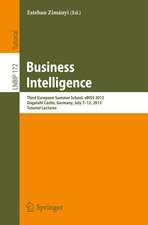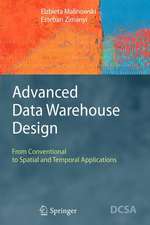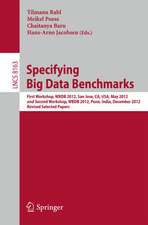Data Warehouse Systems: Design and Implementation: Data-Centric Systems and Applications
Autor Alejandro Vaisman, Esteban Zimányien Limba Engleză Paperback – 17 iul 2023
As a key characteristic of the book, most of the topics are presented and illustrated using application tools. Specifically, a case study based on the well-known Northwind database illustrates how the concepts presented in the book can be implemented using Microsoft Analysis Services and Power BI. All chapters have been revised and updated to the latest versions of the software tools used. KPIs and Dashboards are now also developed using DAX and Power BI, and the chapter on ETL has been expanded with the implementation of ETL processes in PostgreSQL. Review questions and exercises complement each chapter to support comprehensive student learning. Supplemental material to assist instructors using this book as a course text is available online and includes electronic versions of the figures, solutions to all exercises, and a set of slides accompanying each chapter.
Overall, students, practitioners and researchers alike will find this book the most comprehensive reference work on data warehouses, with key topics described in a clear and educational style.
“I can only invite you to dive into the contents of the book, feeling certain that once you have completed its reading (or maybe, targeted parts of it), you will join me in expressing our gratitude to Alejandro and Esteban, for providing such a comprehensive textbook for the field of data warehousing in the first place, and for keeping it up to date with the recent developments, in this current second edition.”
From the foreword by Panos Vassiliadis, University of Ioannina, Greece.
| Toate formatele și edițiile | Preț | Express |
|---|---|---|
| Paperback (2) | 499.23 lei 6-8 săpt. | |
| Springer Berlin, Heidelberg – 17 iul 2023 | 499.23 lei 6-8 săpt. | |
| Springer Berlin, Heidelberg – 23 aug 2016 | 549.10 lei 6-8 săpt. | |
| Hardback (1) | 609.89 lei 3-5 săpt. | +50.64 lei 4-10 zile |
| Springer Berlin, Heidelberg – 16 iul 2022 | 609.89 lei 3-5 săpt. | +50.64 lei 4-10 zile |
Din seria Data-Centric Systems and Applications
- 20%
 Preț: 777.07 lei
Preț: 777.07 lei - 20%
 Preț: 430.26 lei
Preț: 430.26 lei - 20%
 Preț: 340.34 lei
Preț: 340.34 lei - 20%
 Preț: 337.91 lei
Preț: 337.91 lei - 20%
 Preț: 1062.89 lei
Preț: 1062.89 lei - 20%
 Preț: 344.76 lei
Preț: 344.76 lei - 20%
 Preț: 663.61 lei
Preț: 663.61 lei - 20%
 Preț: 607.51 lei
Preț: 607.51 lei - 20%
 Preț: 347.74 lei
Preț: 347.74 lei - 20%
 Preț: 512.72 lei
Preț: 512.72 lei - 20%
 Preț: 339.14 lei
Preț: 339.14 lei - 20%
 Preț: 698.57 lei
Preț: 698.57 lei - 20%
 Preț: 650.27 lei
Preț: 650.27 lei - 20%
 Preț: 375.69 lei
Preț: 375.69 lei - 20%
 Preț: 420.84 lei
Preț: 420.84 lei - 20%
 Preț: 479.30 lei
Preț: 479.30 lei - 20%
 Preț: 321.70 lei
Preț: 321.70 lei - 20%
 Preț: 726.16 lei
Preț: 726.16 lei - 20%
 Preț: 333.50 lei
Preț: 333.50 lei - 20%
 Preț: 834.36 lei
Preț: 834.36 lei - 20%
 Preț: 333.88 lei
Preț: 333.88 lei - 20%
 Preț: 520.82 lei
Preț: 520.82 lei
Preț: 499.23 lei
Preț vechi: 624.05 lei
-20% Nou
Puncte Express: 749
Preț estimativ în valută:
95.54€ • 103.74$ • 80.25£
95.54€ • 103.74$ • 80.25£
Carte tipărită la comandă
Livrare economică 22 aprilie-06 mai
Preluare comenzi: 021 569.72.76
Specificații
ISBN-13: 9783662651698
ISBN-10: 3662651696
Pagini: 696
Ilustrații: XXVI, 696 p.
Dimensiuni: 155 x 235 mm
Greutate: 1.09 kg
Ediția:2nd ed. 2022
Editura: Springer Berlin, Heidelberg
Colecția Springer
Seria Data-Centric Systems and Applications
Locul publicării:Berlin, Heidelberg, Germany
ISBN-10: 3662651696
Pagini: 696
Ilustrații: XXVI, 696 p.
Dimensiuni: 155 x 235 mm
Greutate: 1.09 kg
Ediția:2nd ed. 2022
Editura: Springer Berlin, Heidelberg
Colecția Springer
Seria Data-Centric Systems and Applications
Locul publicării:Berlin, Heidelberg, Germany
Cuprins
Part I: Fundamental Concepts.- 1. Introduction.- 2. Database Concepts.- 3. Data Warehouse Concepts.- 4. Conceptual Data Warehouse Design.- 5. Logical Data Warehouse Design.- 6. Data Analysis in Data Warehouses.- 7. Data Analysis in the Northwind Data Warehouse.- Part II: Implementation and Deployment.- 9. Physical Data Warehouse Design.- 9. Extraction, Transformation, and Loading.- 10. A Method for Data Warehouse Design.- Part III: Advanced Topics.- 11. Temporal and Multiversion Data Warehouses.- 12. Spatial and Mobility Data Warehouses.- 13. Graph Data Warehouses.- 14. Semantic Web Data Warehouses.- 15. Recent Developments in Big Data Warehouses.
Notă biografică
Alejandro Vaisman is a professor at the Instituto Tecnológico de Buenos Aires, where he also chairs the graduate program in data science. He has been a professor and chair of the master’s program in data mining at the University of Buenos Aires (UBA) and professor at Universidad de la República in Uruguay. His research interests are in the fields of relational databases, graph databases, business intelligence, and geographic information systems.
Esteban Zimányi is a professor and Director of the Department of Computer and Decision Engineering at the Université Libre de Bruxelles. His current research interests include data warehouses and business intelligence, spatio-temporal and mobility databases, as well as the semantic Web. He coordinated the Erasmus Mundus master’s and doctorate programmes “Information Technologies for Business Intelligence” (IT4BI) and “Big Data Management and Analytics” (BDMA) as well as the Marie Skłodowska-Curie doctorate programme “DataEngineering for Data Science” (DEDS).
Esteban Zimányi is a professor and Director of the Department of Computer and Decision Engineering at the Université Libre de Bruxelles. His current research interests include data warehouses and business intelligence, spatio-temporal and mobility databases, as well as the semantic Web. He coordinated the Erasmus Mundus master’s and doctorate programmes “Information Technologies for Business Intelligence” (IT4BI) and “Big Data Management and Analytics” (BDMA) as well as the Marie Skłodowska-Curie doctorate programme “DataEngineering for Data Science” (DEDS).
Textul de pe ultima copertă
With this textbook, Vaisman and Zimányi deliver excellent coverage of data warehousing and business intelligence technologies ranging from the most basic principles to recent findings and applications. To this end, their work is structured into three parts. Part I describes “Fundamental Concepts” including conceptual and logical data warehouse design, as well as querying using MDX, DAX and SQL/OLAP. This part also covers data analytics using Power BI and Analysis Services. Part II details “Implementation and Deployment,” including physical design, ETL and data warehouse design methodologies. Part III covers “Advanced Topics” and it is almost completely new in this second edition. This part includes chapters with an in-depth coverage of temporal, spatial, and mobility data warehousing. Graph data warehouses are also covered in detail using Neo4j. The last chapter extensively studies big data management and the usage of Hadoop, Spark, distributed, in-memory, columnar, NoSQL and NewSQLdatabase systems, and data lakes in the context of analytical data processing.
As a key characteristic of the book, most of the topics are presented and illustrated using application tools. Specifically, a case study based on the well-known Northwind database illustrates how the concepts presented in the book can be implemented using Microsoft Analysis Services and Power BI. All chapters have been revised and updated to the latest versions of the software tools used. KPIs and Dashboards are now also developed using DAX and Power BI, and the chapter on ETL has been expanded with the implementation of ETL processes in PostgreSQL. Review questions and exercises complement each chapter to support comprehensive student learning. Supplemental material to assist instructors using this book as a course text is available online and includes electronic versions of the figures, solutions to all exercises, and a set of slides accompanying each chapter.
Overall, students, practitioners and researchers alike will find this book the most comprehensive reference work on data warehouses, with key topics described in a clear and educational style.
“I can only invite you to dive into the contents of the book, feeling certain that once you have completed its reading (or maybe, targeted parts of it), you will join me in expressing our gratitude to Alejandro and Esteban, for providing such a comprehensive textbook for the field of data warehousing in the first place, and for keeping it up to date with the recent developments, in this current second edition.”
From the foreword by Panos Vassiliadis, University of Ioannina, Greece.
As a key characteristic of the book, most of the topics are presented and illustrated using application tools. Specifically, a case study based on the well-known Northwind database illustrates how the concepts presented in the book can be implemented using Microsoft Analysis Services and Power BI. All chapters have been revised and updated to the latest versions of the software tools used. KPIs and Dashboards are now also developed using DAX and Power BI, and the chapter on ETL has been expanded with the implementation of ETL processes in PostgreSQL. Review questions and exercises complement each chapter to support comprehensive student learning. Supplemental material to assist instructors using this book as a course text is available online and includes electronic versions of the figures, solutions to all exercises, and a set of slides accompanying each chapter.
Overall, students, practitioners and researchers alike will find this book the most comprehensive reference work on data warehouses, with key topics described in a clear and educational style.
“I can only invite you to dive into the contents of the book, feeling certain that once you have completed its reading (or maybe, targeted parts of it), you will join me in expressing our gratitude to Alejandro and Esteban, for providing such a comprehensive textbook for the field of data warehousing in the first place, and for keeping it up to date with the recent developments, in this current second edition.”
From the foreword by Panos Vassiliadis, University of Ioannina, Greece.
Caracteristici
Extensive coverage of all data warehouse issues, from basic technologies to the most recent findings and systems Review questions and exercises for each chapter, website with teaching material and solutions to all exercises Concepts illustrated by an ongoing example based on the Northwind database using open source and commercial tools
Recenzii
“The book is very well suited for one or more data warehouse courses, ranging from the most basic to the most advanced. It has all the features that are necessary to make a good textbook. (…) The one thing which really set this book apart from its peers is the coverage of advanced data warehouse topics (…) The book also provides a useful overview of novel “Big Data" technologies like Hadoop, and novel database and data warehouse architectures like in-memory databases, column stores, and right-time data warehouses.” from the foreword by Torben Bach Pedersen, Aalborg Universiteit, Denmark



























